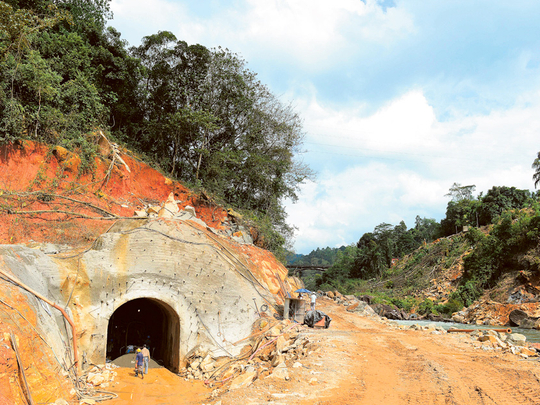
Kitulgala: Its detonation is one of the most iconic scenes in movie history.
Now, 57 years after it was blown to smithereens, authorities in Sri Lanka plan to rebuild the Bridge on the River Kwai to assuage the anger among locals over a controversial dam project.
While the World War II epic was supposedly set in Japanese-held Burma (present-day Myanmar), it was mostly filmed in Ceylon (now Sri Lanka) between 1956 and 1957, less than a decade after independence from Britain.
The final scene in which a British officer played by Alec Guinness blows up a rail bridge that his fellow prisoners of war have just built was shot at sleepy Kitulgala, two hours’ drive from the capital Colombo.
In recent years, the village has become a magnet for adrenalin junkies who can white-water raft down the river, whose real name is the Kelani.
So when Sri Lanka’s Electricity Board unveiled plans to dam the river as part of an $82 million (Dh301 million) hydro-electric project, there was widespread dismay among locals whose livelihoods depend on tourism.
But in a bid to soften the blow, the electricity board has announced that it will pay for the reconstruction of a new wooden bridge, built on the original’s foundations, to attract fans of the Oscar-winning movie.
“We have offered to rebuild the bridge at the same location,” the board’s chief project engineer Kamal Laksiri told AFP on a visit to Kitulgala which is around 90 kilometres north-east of Colombo.
“Today there is no bridge, only a few concrete posts remain. But we have looked at drawings and pictures of the bridge and we will recreate it.”
The explosion scene, in which a train packed with Japanese VIPs derails and then plunges into the river below, had to be shot twice in 1957 after a cameraman failed to give the correct signal to director David Lean.
Elephants were used to haul the train out of the river for the second take and locals used the wooden debris to build homes or keep as souvenirs.
While only a few concrete stumps serve as testament to the dramatic finale, 59-year-old Chandralatha Jayawardena still steers foreigners to the river along a leach-infested path on a daily basis.
“My husband was an extra in the movie and we earn a living by guiding tourists,” she said.
After Sri Lanka’s 37-year ethnic conflict came to an end in 2009, Sri Lanka’s tourist industry has been steadily growing and more than 1.2 million foreigners are expected to visit this year.
While most head for the beaches, Kitulgala has carved out a niche as a white water rafting destination, generating nearly $20 million last year.
Adventure sports operators in Kitulgala say the project to build a dam at Broadlands, a few kilometres upstream, will tame the 17 separate classified rapids on their stretch of water.
The Sri Lanka White Water Rafting Association, which represents more than a dozen firms, rejected the idea that a rebuilt bridge would offset the damage.
“If there is no rafting, there will be no need for tourists to come here,” the association’s secretary, Priyantha Pushpakumara, told AFP at his Ceylon Adventure resort on the banks of the Kelani.
“What is the income you can get by issuing tickets to see a brand new bridge? That is not what we want. Even if you build it, what is the point? There will be no water under the bridge.”
The electricity board says it will release water from the dam during the day so water sports can continue, although it concedes at night a section of the river will go dry.
“This will be a model for sustainable development,” engineer Laksiri said.
“We will lose some energy [by releasing water during the day], but we are willing to do that.”
Tourism chiefs say the rebuilt bridge, along with a new visitor museum, will guarantee Kitulgala remains on the tourist map.
“Kitulgala was always promoted as the place of the bridge in the Bridge on the River Kwai,” Rumy Jauffer, the Sri Lanka tourism promotion bureau’s managing director, said.
“Recreating that bridge will certainly add value.”
But Alfred Haslinger, an Austrian who steers thrill-seekers along the rapids on his rubber raft, is unconvinced by such assurances.
“You can’t just turn a river on and off,” he said. “It won’t be the same again. It is really a shame.”











